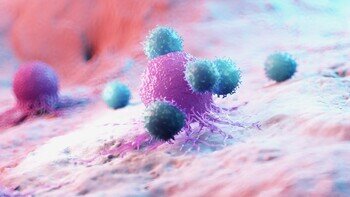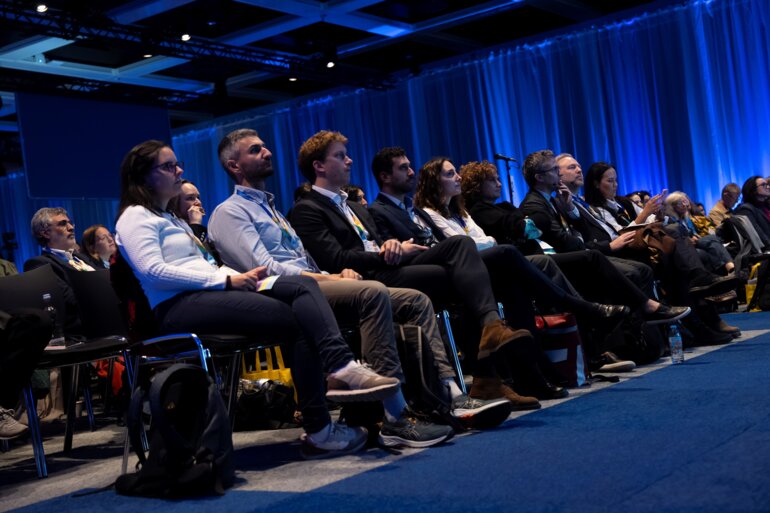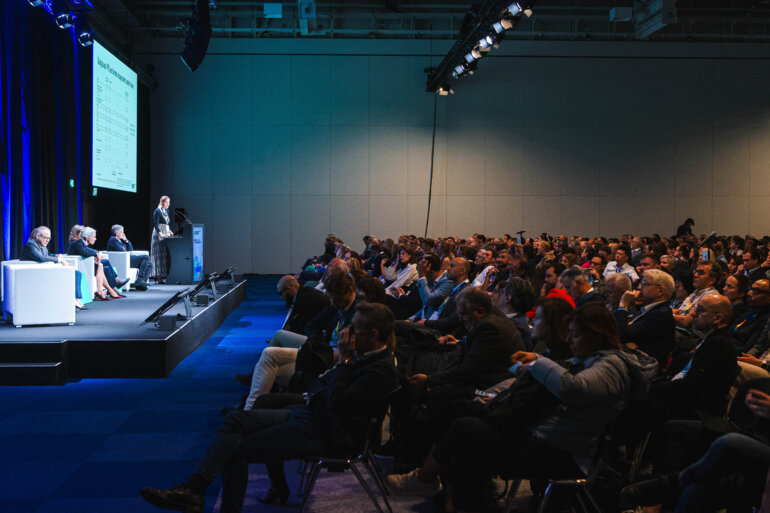Promising results with cancer vaccines based on specific antigen mutations in individual tumours, and typically used in combination with checkpoint inhibitors, are fuelling an upsurge of interest in cancer vaccination for patients with established cancer, explains Prof. Pedro Romero.
The speed with which some novel COVID-19 vaccines have arrived in clinics owes much to recent advances in innovative technologies for vaccines for the treatment of established cancer. Prof. Pedro Romero, Department of Fundamental Oncology, University of Lausanne Ludwig Cancer Research, Switzerland, discusses the latest findings and looks towards a future where cancer vaccination could be part of routine treatment for some patients.
What are the most encouraging approaches to vaccination therapy for patients with established cancer?
Vaccination therapy in a patient with an established cancer aims to induce an immune response that will destroy their cancer cells. There are two main approaches for designing vaccines activating the tumour-specific T cells that are needed for this response (Sci Transl Med. 2016 Apr 13;8(334):334ps9). One uses whole tumour cell-based vaccines that expose patients to all the protein antigens in their cancer, any or all of which may activate the necessary T cells. The other uses sub-unit vaccines that contain only selected antigens – those considered most likely to trigger the desired T cell response.
Sub-unit vaccines are scientifically very satisfying because, unlike a whole cell vaccine, you know exactly what is in them and they are rationally designed to evoke a specific immune reaction against a specific target.
At present, some of the most interesting results are being seen with sub-unit vaccines that contain neoantigens – mutated antigens that are highly specific to each patient’s tumour.
These neoantigens cannot stimulate an effective immune response on their own so the sub-unit vaccine also contains a potent immunological adjuvant that activates dendritic cells to present the neoantigen to the immune system and a vehicle that acts as a carrier for the neoantigen and the adjuvant. In the past, people used mineral oil-based emulsions or other substances as this vehicle, but more recently they have been using biomaterials to create nanoparticles as vehicles and there is particular interest in using cationic lipid technology to make synthetic lipids called lipoplexes.
In which cancers are these sub-unit vaccines showing most promise?
The only Food and Drug Administration (FDA) approved sub-unit cancer vaccine is Provenge (sipuleucel-T) which was shown to increase overall survival by about four months in men with advanced castration-resistant prostate cancer (CRPC), which is comparable with other targeted therapies for these patients (Pharmacy and Therapeutics 2011; 36(4): 197-202). However, as the production of the vaccine, based on the antigen, prostatic acid phosphatase (PAP)-GM-CSF fusion protein, requires culture of patient peripheral blood mononuclear cells in a dedicated cell manufacturing factory and is very cumbersome, its use is mainly limited to tertiary cancer centres.
We have recently seen promising results with a sub-unit vaccine, called TG4001, in patients with recurrent/metastatic human papilloma virus (HPV) 16-positive anal, oropharyngeal, cervical or vulvar/vaginal cancer (Annals of Oncology 2020; 31 (suppl_7): S1441-S1451. 10).
This is an HPV E6/E7 vaccine, which uses a modified Vaccinia Ankara virus as a vehicle, and it is combined with avelumab, an anti-PD-L1 monoclonal antibody checkpoint inhibitor. Of 34 patients vaccinated over several months, seven achieved a partial response and one a complete response. So that is an overall response of about 23.5%. It is certainly promising, but we now need a randomised trial powered to show clinical benefits, so there is still a long way to go.
Are personalised neoantigen vaccines also a promising option in cancer care?
We are starting to see promising results with personalised neoantigen vaccines, though these require a massive effort involving a specialised genomics and bioinformatics pipeline to identify neoantigens in each patient’s tumour that may be suitable for vaccination. This is currently very time consuming, inefficient and expensive.
Personalised neoantigen vaccines were given as synthetic peptides and a Toll-like receptor (TLR) agonist to patients with metastatic melanoma (Nature 2017 Jul 13;547(7662):217-221), or newly diagnosed with the brain cancer, glioblastoma, following surgical resection and conventional radiotherapy (Nature 2019 Jan;565(7738):234-239). Neoantigen-specific CD8+ and CD4+ T cell responses were achieved in practically all cases, along with an increase in the number of tumour-infiltrating T cells. CD8+ and CD4+ T cells are the cell-killing and helper T cell populations, respectively, that are key to the immune response against tumour cells. Neoantigen-specific T cells from the peripheral blood were shown to migrate into an intracranial glioblastoma tumour.
In another larger study, a personalised neoantigen-based vaccine, NEO-PV-01, again in the form of synthetic peptides and TLR agonist combined with a PD-1 inhibitor, was given to 82 patients with advanced melanoma, non-small-cell lung cancer (NSCLC) or bladder cancer (Cell 2020 Oct 15;183(2):347-362). After vaccination, neoantigen-specific CD8+ and CD4+ T cell responses were seen in all the patients and these vaccine-induced T cells were capable of moving to the tumour and mediating cell killing. Treatment was well tolerated and further studies are planned which will hopefully show clinical responses.
What progress is being made with mRNA-based cancer vaccines?
A growing number of studies are reporting results with mRNA vaccines that code for multiple neoantigens in a patient’s tumour with the aim of triggering the desired CD8+ and CD4+ T cell responses needed to destroy tumours.
In a proof-of-principle study in patients with melanoma, a research group from BioNTech and academic institutions in Germany showed it was possible to elicit targeted anti-tumour T cell responses using personalised synthetic mRNA vaccines coding for up to 10 neoantigens as nanoparticles assembled with cationic lipids (Nature. 2017 Jul 13;547(7662):217-221). Of six vaccinated patients, four had no recurrence at 25 months after vaccination, while two with recurrent disease were subsequently treated with anti-PD-1 checkpoint therapy and experienced complete tumour regression, with an accompanying expanded range of neoantigen-specific T cells.
In a subsequent Phase 1 dose escalation study in a total of 42 patients with advanced unresectable melanoma, the same group reported findings with the liposomal mRNA vaccine, FixVac (BNT111), targeting four non-mutated, tumour-associated antigens (Nature 2020 Sep;585(7823):107-112). The vaccine, alone or in combination with PD-1 checkpoint blockade, mediated durable partial responses or stable disease accompanied by induction of strong CD4+ and CD8+ T cell immunity against the vaccine antigens.
Preliminary data have also been reported from a Phase 1b study of BI1361849 (CV9202), an mRNA vaccine, stabilised with the cation protamine, encoding six NSCLC associated antigens administered with local radiation in 26 patients with stage IV NSCLC with partial response/stable disease after standard first-line therapy (Journal for Immunotherapy of Cancer, 08 Feb 2019, 7(1):38). Treatment was well tolerated and 84% of patients had increased BI1361849 antigen-specific immune responses. Best overall response was stable disease in 46.2% of patients.
MRNA-based vaccines, loaded onto autologous dendritic cells, have also shown promising results in combination with ipilimumab in advanced melanoma (J Immunother Cancer 2020 Feb;8(1):e000329) and in patients with gastrointestinal cancer (J Clin Invest. 2020 Nov 2;130(11):5976-5988). It is the mRNA-cationic lipid technology which has been adapted for some COVID-19 vaccines.
What has led to the current increased interest in cancer vaccines?
One reason for the enthusiasm in cancer vaccines is the opportunity to use them in combination with checkpoint inhibitors – as in some of the previously mentioned studies. Checkpoint inhibitors alone have been showing good responses in some cancers, including NSCLC, melanoma and bladder cancer, for some time, but we only see good responses in up to 30% of patients. By using cancer vaccines to sensitise tumours to the effects of checkpoint inhibitors we hope to increase the proportion of responders compared to using either vaccines or checkpoint inhibitors alone. There are many ongoing clinical trials now testing these combinations and there are high hopes for promising results.
What are the main challenges currently facing cancer vaccine research?
The main challenge is to make these vaccines clinically effective – that they demonstrably delay tumour growth and improve disease-free survival (DFS) and ideally that we can get complete durable responses. The other challenge is to find biomarkers of efficacy so that we can predict clinical effectiveness without having to wait for tumour shrinkage or DFS.
There is also enthusiasm for testing these vaccines in patients who have had treatment and are disease free to see if we can prevent recurrence. However, we need a strong rationale and convincing safety data to go in this direction.
In addition, we still need to overcome the technical challenges of making a cancer vaccine. Giving a whole protein antigen to the immune system in a cancer vaccine does not mimic what normally happens when antigens are processed and presented to T cells, especially the CD8+ cells that are most important for the cytotoxic effects. Researchers are experimenting with short and longer sequences of antigenic peptides, but we still have a lot to learn about the optimal way of formulating cancer vaccines.
Could cancer vaccination ultimately become a routine part of treatment for common cancers?
If it becomes a reality, neoantigen vaccination could become part of our algorithms for personalised cancer therapies in specialised cancer centres in the next 10 years – perhaps using mRNA technology. It is not long ago that we did not believe that mRNA-based vaccines could work because the immune responses they triggered were too weak, but now we have mRNA COVID-19 vaccines that are at least 90% effective, a very impressive result. At the moment, we know that the mRNA COVID-19 vaccines induce spike protein specific neutralising antibodies and we do not yet know if mRNA vaccines will give us the powerful cytotoxic T cell responses we need in cancer treatment. We do not know either about the durability of those responses or the quality of memory immune responses. But we are seeing a very exciting drive in innovative ideas for cancer vaccines of the future.








